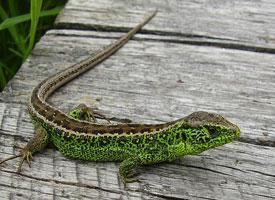
Váhy a míry
| Délka | 40 cm |
|---|
Popis zvířete
The European green lizard (Lacerta viridis) is a striking and vibrant reptile that is native to many parts of Europe and into the fringes of Asia. It is a member of the Lacertidae family, which is known for its diverse and often brightly colored species. The European green lizard, in particular, is celebrated for its vivid green coloration, which serves as both camouflage in its natural habitat and a spectacular display during mating season.Physical Description:
This species exhibits a robust and streamlined body, typically reaching lengths of about 40 cm (15.7 inches), including its tail, which can be twice as long as its body. Males are generally larger and more brightly colored than females, showcasing a brilliant emerald green back and sides that may be adorned with small, darker spots. Females, while also green, tend to have a more subdued hue and may display a series of dark streaks or spots along their sides. Both sexes have a creamy white or yellowish underbelly, and during the breeding season, males develop a striking blue throat and jaw, adding to their colorful appeal.
Habitat and Distribution:
The European green lizard thrives in a variety of habitats, including open forests, shrublands, meadows, and even semi-urban areas where green spaces are available. They prefer environments that offer plenty of sunlight and hiding spots, such as under rocks, within dense vegetation, or among fallen leaves. Their distribution spans across central and southeastern Europe, extending into parts of southwestern Asia. They are particularly prevalent in countries like Hungary, Austria, Slovakia, and parts of the Balkans.
Behavior and Diet:
Primarily diurnal, the European green lizard is an active hunter during the day. Its diet consists mainly of insects, including crickets, beetles, and caterpillars, but it can also consume other small invertebrates, and occasionally, plant material. This lizard is known for its agility and speed, which it uses to chase down prey or flee from predators. When threatened, it can drop its tail (a process known as autotomy) to distract the predator and make its escape. The tail will regrow, though it may not reach its original length or coloration.
Reproduction:
Breeding season for the European green lizard typically occurs in the spring, following their emergence from hibernation. Males engage in dramatic displays of color and physical confrontations to assert dominance and win mates. Females lay clutches of 6 to 20 eggs in warm, moist soil or under decaying vegetation, where the temperature helps determine the sex of the offspring. The eggs hatch after about two to three months, and the young lizards are independent from birth, growing rapidly to reach maturity in one to two years.
Conservation Status:
The European green lizard is currently listed as Least Concern by the International Union for Conservation of Nature (IUCN), indicating that it is not presently at significant risk of widespread decline. However, like many species, it faces threats from habitat destruction, pollution, and the impacts of climate change, which could affect its populations in the future. Conservation efforts are focused on preserving natural habitats and promoting biodiversity to ensure the continued survival of this and other species.
In summary, the European green lizard is a fascinating and beautiful reptile that adds a splash of color to the landscapes of Europe and western Asia. Its presence is a sign of healthy, biodiverse ecosystems, and its survival is linked closely to the conservation of its natural habitats.
Mapa výskytu

Podobná zvířata
Nové fotografie zvířat
Top 10 zvířat
- Dolphin gull (Leucophaeus scoresbii)
- Diana monkey (Cercopithecus diana)
- Moustached guenon (Cercopithecus cephus)
- Galápagos tortoise (Geochelone nigra complex)
- Stone loach (Barbatula barbatula)
- Japanese macaque (Macaca fuscata)
- Russian tortoise (Testudo horsfieldii)
- Greek tortoise (Testudo graeca)
- Common flying dragon (Draco volans)
- Vendace (Coregonus albula)


